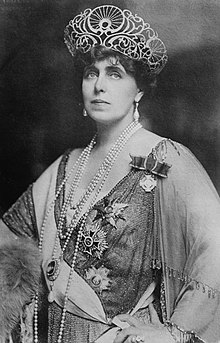
Back Maria van Roemenië Afrikaans ماريا ملكة رومانيا Arabic ماريا ملكة رومانيا ARZ Edinburqlu Mariya Azerbaijani ماری ادینبورق AZB Мария Единбургска Bulgarian Maria del Regne Unit (reina de Romania) Catalan Marie Edinburská Czech Marie af Rumænien Danish Marie von Edinburgh German
| Marie | |||||
|---|---|---|---|---|---|
 | |||||
| Queen consort of Romania | |||||
| Tenure | 10 October 1914 – 20 July 1927 | ||||
| Coronation | 15 October 1922 | ||||
| Born | Princess Marie of Edinburgh 29 October 1875 Eastwell Park, Kent, England | ||||
| Died | 18 July 1938 (aged 62) Pelișor Castle, Sinaia, Romania | ||||
| Burial | 24 July 1938[1] | ||||
| Spouse | |||||
| Issue | |||||
| |||||
| House | Saxe-Coburg and Gotha | ||||
| Father | Alfred, Duke of Saxe-Coburg and Gotha | ||||
| Mother | Grand Duchess Maria Alexandrovna of Russia | ||||
| Signature | |||||
Marie (born Princess Marie Alexandra Victoria of Edinburgh; 29 October 1875 – 18 July 1938)[note 1] was the last queen of Romania as the wife of King Ferdinand I.
Marie was born into the British royal family. Her parents were Prince Alfred, Duke of Edinburgh (later Duke of Saxe-Coburg and Gotha), and Grand Duchess Maria Alexandrovna of Russia. Marie's early years were spent in Kent, Malta and Coburg. After refusing a proposal from her cousin, the future King George V, she was chosen as the future wife of Ferdinand, then crown prince of Romania, in 1892. Marie was crown princess between 1893 and 1914, and became immediately popular with the Romanian people.
After the outbreak of World War I, Marie urged Ferdinand to ally himself with the Triple Entente and declare war on Germany, which he eventually did in 1916. During the early stages of fighting, the national capital Bucharest was occupied by the Central Powers. Marie, Ferdinand and their five children took refuge in Western Moldavia. There, she and her three daughters acted as nurses in military hospitals, caring for soldiers who were wounded or afflicted by cholera. After the war, on 1 December 1918, the historical region of Transylvania, following Bessarabia and Bukovina, united with the Old Kingdom. Marie, now queen of Greater Romania, attended the Paris Peace Conference of 1919, where she campaigned for international recognition of the enlarged Romania. In 1922, she and Ferdinand were crowned in a specially-built cathedral in the ancient city of Alba Iulia, in an elaborate ceremony which mirrored their status as queen and king of a united state.
As queen, Marie was very popular, both in Romania and abroad. In 1926, she undertook a diplomatic tour of the United States, alongside her children Nicholas and Ileana. They were received enthusiastically by the people and visited several cities before returning to Romania. There, Marie found that Ferdinand was gravely ill and he died a few months later. Now queen dowager, Marie refused to be part of the regency council which reigned over the country under the minority of her grandson, King Michael. In 1930, Marie's eldest son Carol, who had waived his rights to succession, deposed his son and usurped the throne, becoming King Carol II. He removed Marie from the political scene and strove to crush her popularity. As a result, Marie moved away from Bucharest and spent the rest of her life either in the countryside or at Balchik Palace, her summer residence in Southern Dobruja by the Black Sea. In 1937, she became ill with cirrhosis and died the following year.
Following Romania's transition to a People's Republic, the monarchy was excoriated by communist officials. Several biographies of the royal family described Marie either as a drunkard or as a promiscuous woman, referring to her many alleged affairs and to orgies she had supposedly organised before and during the war. In the years preceding the Romanian Revolution of 1989, Marie's popularity recovered and she was offered as a model of patriotism to the population. Marie is primarily remembered for her work as a nurse, but is also known for her extensive writing, including her critically acclaimed autobiography.
- ^ United Press (19 July 1938). "Roumanian Queen to Lie in State at Son's Palace". Delaware County Daily Times. Beaver and Rochester, Penn. p. 12.
Cite error: There are <ref group=note> tags on this page, but the references will not show without a {{reflist|group=note}} template (see the help page).